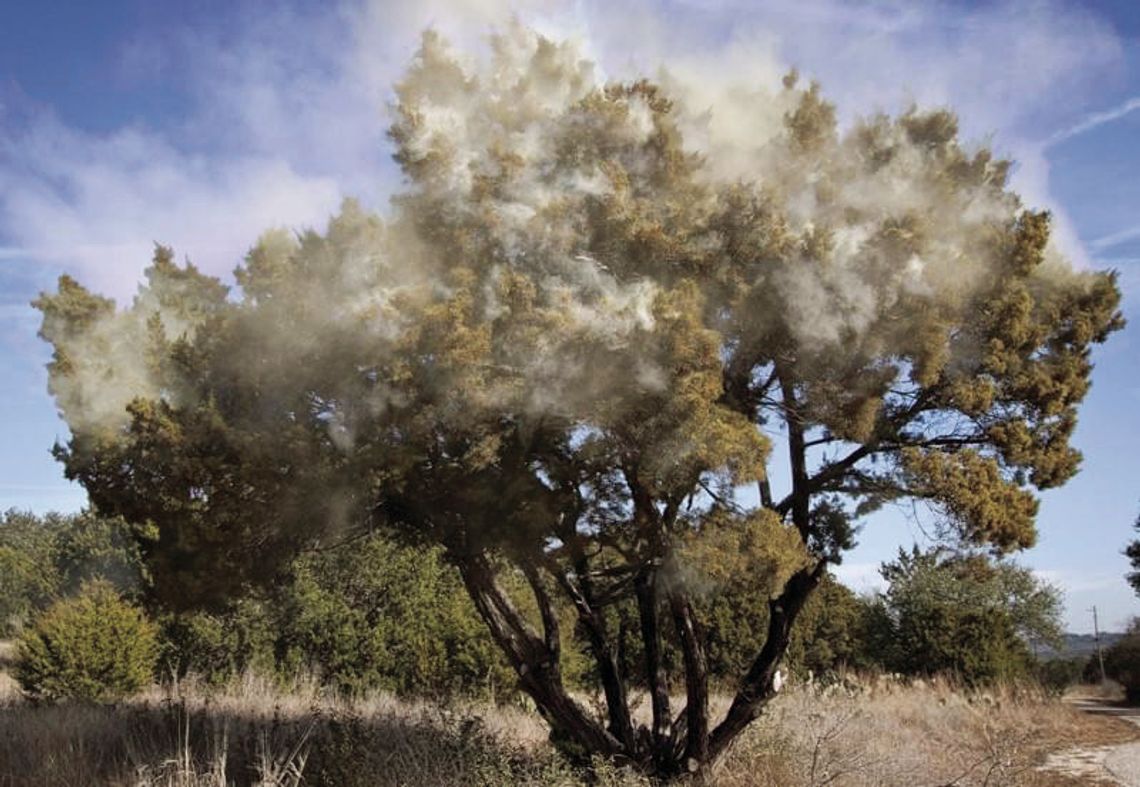It’s time for Texans to brace for ‘cedar fever’ season once again. Cedar fever is an allergic reaction to the pollen released by mountain cedar trees and, unfortunately, you don’t have to be allergic to the pollen for it to affect you.
In Texas, what is known colloquially as mountain cedar is actually Ashe juniper, making cedar fever especially irritating in the Hill Country west of Interstate 35, where Ashe juniper trees are the dominant canopy cover alongside oaks and a few other species.
“Cedar fever is irritating to many due to the quantity and density of Ashe junipers in Central Texas that all produce pollen at the same time, which leads to a high concentration of pollen in the air,” said Robert Edmonson, Texas A&M Forest Service biologist and certified arborist.
The pollen from Ashe junipers isn’t particularly allergenic or harmful, but its concentration is what irritates most because your body perceives it as a threat and begins to fight it.
Since the pollen is spread by wind, cedar fever can even affect individuals who are not near a high concentration of juniper trees. And the source isn’t limited to Ashe junipers. In more eastern parts of the state, eastern red cedars pollinate around the same time and can induce a similar response from people’s autoimmune systems.
Besides the massive quantity of pollen released, cedar fever is also problematic because of the timing of the pollen release.
Most trees pollinate in the spring when many people are expecting to have allergies. Ragweed pollen and mold spores can contribute to allergies in the fall, but very few plants pollinate during the winter.
Juniper trees are the exception.
These trees typically begin producing pollen in mid-December, often triggered by colder weather or the passage of a cold front. Pollen production peaks in mid-January before slowly tapering off toward the beginning of March.
“Cold fronts are marked by very dry and windy conditions with rapid pressure changes which trigger pollen cones to open and release pollen grains,” Edmonson said. “In certain conditions, you can even see the pollen blowing off trees.”
Not to be confused with seasonal illnesses
For people new to the Central Texas region or unfamiliar with cedar fever, it can also lead to confusion since the pollination period of mountain cedar trees occurs during the peak of cold and flu season.
It’s not uncommon for people experiencing cedar fever to mistake their symptoms for a cold or the seasonal flu, especially given the variety of symptoms triggered by cedar fever. These include fatigue, sore throat, runny nose, partial loss of smell and a slight fever in some. However, if your fever is higher than 101.5 degrees, then pollen likely isn’t the cause.
Helpful tips
Texas A&M Forest Service offered the following tips to help Texans get through the cedar fever season:
• Treat cedar fever by taking allergy medications and antihistamines, but consult your physician or health care professional before taking new medications.
• Anticipate the pollen by tuning in to the local news station, many of which will give the pollen count and can predict when it will be a particularly pollen-heavy day.
• On pollen-heavy days, keep windows and doors closed and limit the time spent outdoors.
• When possible, install higher MERV-rated air filters in home and auto HVAC systems and invest in home air purifiers.
Removing juniper trees from your property isn’t recommended primarily because the pollen is airborne and — since they often wait to release their pollen until it’s cold, dry and windy — that pollen can blow for miles. It’s also important to note that only male juniper trees release pollen.
“The male trees have larger pollen cones, while the female trees have much smaller reproductive cones, which are very inconspicuous, but that’s what is pollinated from the male trees,” Edmonson said.
While cedar fever might sound and seem particularly hostile, Ashe junipers are just a species like any other, feeling out the conditions and waiting for the perfect moment to release their pollen to set their offspring up for success come springtime.
For more information about identifying Ashe junipers and/or eastern red cedars in your backyard, check out Texas A&M Forest Service’s Texas Tree ID webpage or the My Tree ID mobile app.
You can also see the distribution of junipers, as well as a variety of other tree species across the state, via our Forest Distribution App.






















